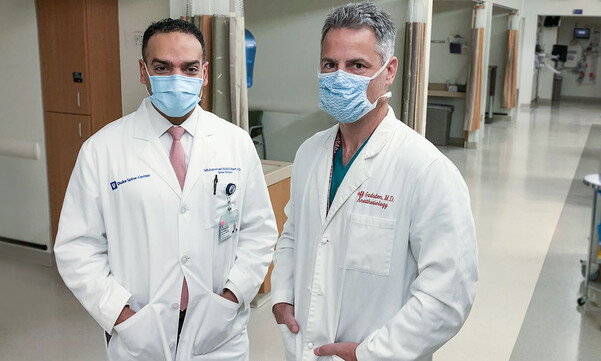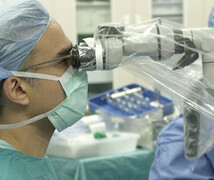After being diagnosed with an unruptured brain aneurysm in fall 2021, Bridget Esposito learned she needed brain surgery to prevent a life-threatening rupture. The thought of receiving general anesthesia made her uncomfortable because she’d experienced bad side effects in the past. Then her Duke neurosurgeon told her about a new option called “awake surgery.” It would allow Esposito to be sedated but remain conscious instead of undergoing general anesthesia. “It was very easy,” said Esposito after her successful awake surgery. “I could have walked out of there right afterwards. That's how great I felt.”
MRI Signals Brain Aneurysm
When Pittsboro, NC resident Bridget Esposito started noticing changes in her vision, an MRI revealed the culprit was a brain aneurysm -- a weak or bulging area in one of the brain’s arteries. If an aneurysm ruptures, it can cause serious disability or death.
After her diagnosis, Esposito, who was 61 at the time, scheduled an appointment with David Hasan, MD, a Duke microvascular surgeon and neurosurgeon who specializes in brain aneurysm treatment. “Dr. Hasan was the most experienced and empathetic doctor we spoke to. That experience made me confident in choosing Duke."
Endovascular Approach Is Less Invasive
Together Dr. Hasan and Esposito came up with a game plan. The aneurysm was stable, but Esposito needed surgery. Due to the location of her aneurysm, Dr. Hasan recommended an endovascular approach to place a flow-diverting stent. Unlike traditional brain aneurysm operations that require an open incision in the skull, endovascular surgery is a less-invasive way to reach blood vessels. A catheter is threaded through a major artery in the groin and up to the aneurysm. Then a stent is placed to direct blood flow away from the area.
Awake Surgery Eliminates Need for General Anesthesia
Once they settled on the endovascular approach, Dr. Hasan told Esposito she was a candidate for “awake surgery,” which meant she could avoid general anesthesia and remain conscious but sedated during the procedure. Esposito said she was a little leery about the idea at first. But when she thought about the nausea, headaches, and fatigue she experienced after waking up from general anesthesia in the past, she agreed it was a better option for her.
During her surgery in May 2022, Esposito said she remembers feeling calm and talking with her care team. According to Dr. Hasan, being able to communicate with the patient and ask them questions during the procedure helps surgeons monitor critical brain functions like speech, movement, and vision and make adjustments immediately. This reduces the risk of potential complications. That’s not possible during standard surgery that uses general anesthesia. In that case, doctors don’t know about any neurological deficits until the patient wakes up.
According to Dr. Hasan, awake surgery also makes endovascular surgery available for people with life-threatening aneurysms who cannot undergo general anesthesia. This includes people with diseases like chronic obstructive pulmonary disease (COPD) and pulmonary hypertension. “At Duke, we can offer patients more options than other centers can,” Dr. Hasan said.
Feeling Great After Awake Surgery
After the hour-long procedure, Esposito felt energized and didn’t have any of the side effects she had experienced before with general anesthesia. “I had a lot more energy,” she said. “Right after the procedure, I was able to eat dinner just like any other day. I felt normal.”
Since her awake surgery, Esposito has been slowly weaning off her blood-thinning medications, watching her blood pressure, and attending regular check-ups. She’s enjoying her hobbies, looking forward to building a new house with her husband, and grateful for how things turned out.




